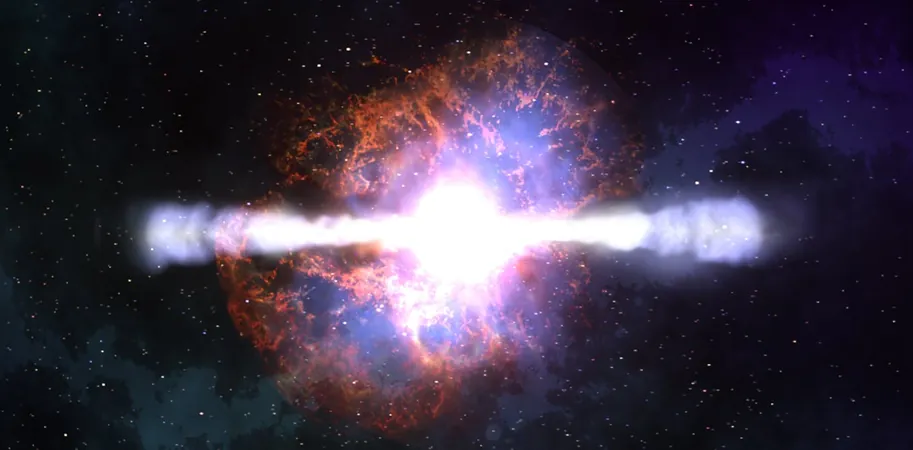
Groundbreaking Discovery: Could Dark Energy Be an Illusion? Study of Supernovas Suggests a New Reality
2025-01-07
Author: Ting
In a stunning revelation that could reshape our understanding of the universe, a recent study analyzing data from distant supernovas has called into question the existence of dark energy, a mysterious force long believed to be responsible for the accelerating expansion of the cosmos. This groundbreaking study proposes an alternative explanation known as the Timescape model.
In 1998, astronomers observed that not only is our universe expanding, but its rate of expansion is also accelerating. This led to the introduction of dark energy into the cosmological framework—an elusive substance thought to make up nearly 70% of the universe’s energy content, yet its true nature remains largely a mystery.
The current standard model of cosmology, known as Lambda-Cold Dark Matter (Lambda-CDM), treats the universe as a homogenous and isotropic expanse. It assumes that matter is uniformly distributed across vast distances. However, the Timescape model—proposed in the recent study—takes a different approach, suggesting that the universe's expansion is influenced by its uneven distribution of matter, including galaxies, clusters, and massive cosmic voids.
What Is Dark Energy?
Dark energy has become one of the most captivating phenomena in modern physics, often described as an energy density that fills space uniformly, counteracting the pull of gravity. Some interpretations liken dark energy to a vacuum energy inherent to space itself, while others suggest it could be a newly evolving field spreading throughout the universe. A recent study even indicated that dark energy might be weakening over time.
Unveiling the Timescape Model
The Timescape model introduces the concept that the expansion of the universe is not uniform; rather, it varies based on the density of matter in different regions. The model posits that regions of space with greater voids experience a faster expansion, creating an optical illusion of an accelerated universe. The key parameter at play here is the 'void fraction,' which measures the amount of space filled by these expanding voids.
Key Findings from the Study
Utilizing one of the largest repositories of Type Ia supernovas, known as the Pantheon+ dataset, researchers compared the Lambda-CDM model to the Timescape model. Their findings showed a significant preference for the Timescape model when accounting for nearby supernovas, which displayed better explanatory power than the conventional Lambda-CDM framework.
Moreover, initial analyses indicated that the Timescape model held slightly better under scrutiny, even with more distant supernovas, suggesting that local cosmic structures impact our perception of cosmic expansion.
Cautions and Considerations
However, it's essential to note some caveats. The study did not fully incorporate the effects of peculiar velocities—random motions of galaxies that could skew supernova measurements. Additionally, it did not use the most up-to-date DES5yr dataset, which could provide more reliable data due to its consistency in observation.
Moreover, the Lambda-CDM model remains supported by other astrophysical phenomena, such as baryon acoustic oscillations and gravitational lensing, aspects that would need to be integrated into any evolving model.
Conclusion: A Shift in Cosmological Thought
The implications of the Timescape model are profound. If confirmed, this research could lead to a paradigm shift in how we comprehend the universe's expansion—a potential revelation that our perception of an accelerating universe is merely a byproduct of how galaxies and voids are distributed in space.
As our quest for understanding the cosmos continues, exciting new possibilities emerge that challenge renowned theories and pave the way for a deeper and potentially more accurate view of our universe’s dynamics. Stay tuned as future explorations in cosmology may illuminate even more astonishing truths about the fabric of reality itself!


 Brasil (PT)
Brasil (PT)
 Canada (EN)
Canada (EN)
 Chile (ES)
Chile (ES)
 Česko (CS)
Česko (CS)
 대한민국 (KO)
대한민국 (KO)
 España (ES)
España (ES)
 France (FR)
France (FR)
 Hong Kong (EN)
Hong Kong (EN)
 Italia (IT)
Italia (IT)
 日本 (JA)
日本 (JA)
 Magyarország (HU)
Magyarország (HU)
 Norge (NO)
Norge (NO)
 Polska (PL)
Polska (PL)
 Schweiz (DE)
Schweiz (DE)
 Singapore (EN)
Singapore (EN)
 Sverige (SV)
Sverige (SV)
 Suomi (FI)
Suomi (FI)
 Türkiye (TR)
Türkiye (TR)
 الإمارات العربية المتحدة (AR)
الإمارات العربية المتحدة (AR)